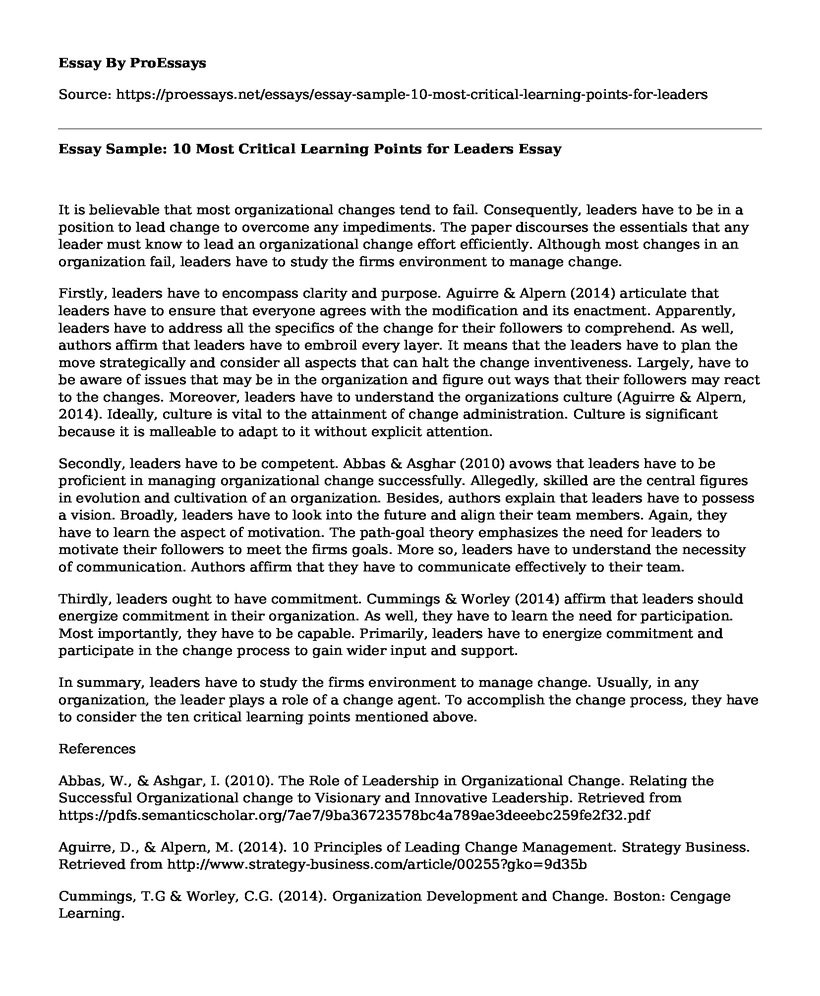It is believable that most organizational changes tend to fail. Consequently, leaders have to be in a position to lead change to overcome any impediments. The paper discourses the essentials that any leader must know to lead an organizational change effort efficiently. Although most changes in an organization fail, leaders have to study the firms environment to manage change.
Firstly, leaders have to encompass clarity and purpose. Aguirre & Alpern (2014) articulate that leaders have to ensure that everyone agrees with the modification and its enactment. Apparently, leaders have to address all the specifics of the change for their followers to comprehend. As well, authors affirm that leaders have to embroil every layer. It means that the leaders have to plan the move strategically and consider all aspects that can halt the change inventiveness. Largely, have to be aware of issues that may be in the organization and figure out ways that their followers may react to the changes. Moreover, leaders have to understand the organizations culture (Aguirre & Alpern, 2014). Ideally, culture is vital to the attainment of change administration. Culture is significant because it is malleable to adapt to it without explicit attention.
Secondly, leaders have to be competent. Abbas & Asghar (2010) avows that leaders have to be proficient in managing organizational change successfully. Allegedly, skilled are the central figures in evolution and cultivation of an organization. Besides, authors explain that leaders have to possess a vision. Broadly, leaders have to look into the future and align their team members. Again, they have to learn the aspect of motivation. The path-goal theory emphasizes the need for leaders to motivate their followers to meet the firms goals. More so, leaders have to understand the necessity of communication. Authors affirm that they have to communicate effectively to their team.
Thirdly, leaders ought to have commitment. Cummings & Worley (2014) affirm that leaders should energize commitment in their organization. As well, they have to learn the need for participation. Most importantly, they have to be capable. Primarily, leaders have to energize commitment and participate in the change process to gain wider input and support.
In summary, leaders have to study the firms environment to manage change. Usually, in any organization, the leader plays a role of a change agent. To accomplish the change process, they have to consider the ten critical learning points mentioned above.
References
Abbas, W., & Ashgar, I. (2010). The Role of Leadership in Organizational Change. Relating the Successful Organizational change to Visionary and Innovative Leadership. Retrieved from https://pdfs.semanticscholar.org/7ae7/9ba36723578bc4a789ae3deeebc259fe2f32.pdf
Aguirre, D., & Alpern, M. (2014). 10 Principles of Leading Change Management. Strategy Business. Retrieved from http://www.strategy-business.com/article/00255?gko=9d35b
Cummings, T.G & Worley, C.G. (2014). Organization Development and Change. Boston: Cengage Learning.
Cite this page
Essay Sample: 10 Most Critical Learning Points for Leaders. (2021, Mar 31). Retrieved from https://proessays.net/essays/essay-sample-10-most-critical-learning-points-for-leaders
If you are the original author of this essay and no longer wish to have it published on the ProEssays website, please click below to request its removal:
- Course Work Example: Management in Health Care
- The Phase of Change by Michael Fullan Essay Example
- Essay Example on Learning and Consumer Behavior: A Study in Decision Making
- Paper Example on Main Character Achieves Success Through Mission Command
- Essay on 7 Tips for Resident Doctors to Handle Stress and Remain Organized
- Essay Example on Tech Industry Diversity: Employer Perceptions, Stereotypes & Unfavourable Climate
- Free Report Sample on Enhancing Leadership Abilities for Army Success







